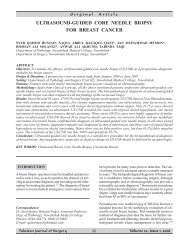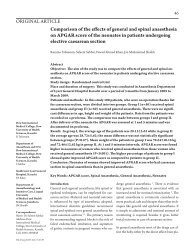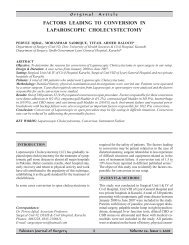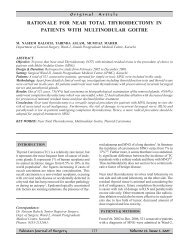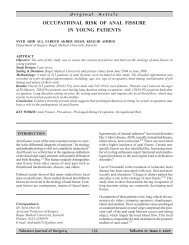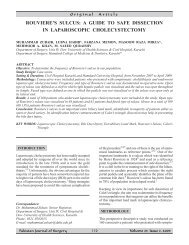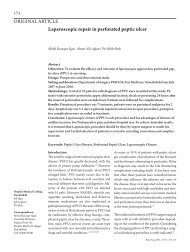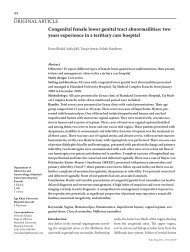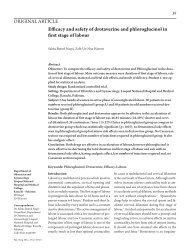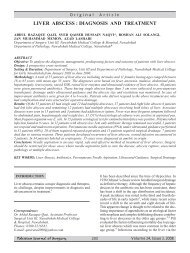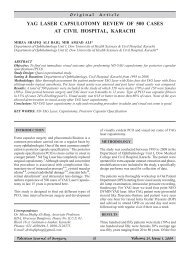Vaginal birth after caesarean section at Liaquat National Hospital
Vaginal birth after caesarean section at Liaquat National Hospital
Vaginal birth after caesarean section at Liaquat National Hospital
Create successful ePaper yourself
Turn your PDF publications into a flip-book with our unique Google optimized e-Paper software.
ORIGINAL ARTICLE<strong>Vaginal</strong> <strong>birth</strong> <strong>after</strong> <strong>caesarean</strong> <strong>section</strong> <strong>at</strong> Liaqu<strong>at</strong> N<strong>at</strong>ional<strong>Hospital</strong>81Aisha Taj, Salma B<strong>at</strong>ool Naqvi, Tahira YasmeenAbstract:Objective: The objective of this study was to evalu<strong>at</strong>e the safety and success of vaginal <strong>birth</strong><strong>after</strong> <strong>caesarean</strong> <strong>section</strong>.Design: cross <strong>section</strong>al study.Place of study: This study was conducted in the department of Obstetrics and gynaecology ofLiaqu<strong>at</strong> n<strong>at</strong>ional hospital.Dur<strong>at</strong>ion of study: 2008-2010.P<strong>at</strong>ients and methods: 123 women meeting the inclusion criteria were included in the study.P<strong>at</strong>ients were monitored during labour for tachycardia, scar tenderness; vaginal bleeding.Fetal monitoring was done by CTG. Progress of labour was monitored by partograph.Results: 123 women with previous one <strong>caesarean</strong> <strong>section</strong> underwent trial of labour, 86(70%)women had successful vaginal <strong>birth</strong> <strong>after</strong> <strong>caesarean</strong> <strong>section</strong>, and 37 (30%) women had repe<strong>at</strong>emergency <strong>caesarean</strong> <strong>section</strong>. Scar dehiscence was suspected in 4 (11%) women; on <strong>caesarean</strong><strong>section</strong> scar dehiscence was confirmed in 3 women. None of the women died or underwenthysterectomy. No perin<strong>at</strong>al mortality occurred.Conclusion: There is emerging evidence of serious harms rel<strong>at</strong>ing to multiple <strong>caesarean</strong><strong>section</strong>.VBAC is a reasonable and safe choice for the majority of women with prior cesareandelivery.Keywords: <strong>Vaginal</strong> <strong>birth</strong> <strong>after</strong> <strong>caesarean</strong> <strong>section</strong>, Trial of labour <strong>after</strong> <strong>caesarean</strong> <strong>section</strong>, M<strong>at</strong>ernalMorbidity, Emergency <strong>caesarean</strong> <strong>section</strong>.Liaqu<strong>at</strong> N<strong>at</strong>ional<strong>Hospital</strong> and MedicalCollage KarachiA TajSB NaqviT YasmeenCorrespondence:Dr. Salma B<strong>at</strong>ool Naqvi.Consultant, Liaqu<strong>at</strong>N<strong>at</strong>ional <strong>Hospital</strong> andMedical Collage, KarachiCell # 0321-2546769email: salmabn@hotmail.comPak J Surg 2012; 28(1):81-84Introduction:Once a <strong>caesarean</strong>, always a <strong>caesarean</strong> 1 was thedomin<strong>at</strong>ed obstetrical practice for many centuries.But as vaginal <strong>birth</strong> <strong>after</strong> cesarean <strong>section</strong>(VBAC) grew in popularity, the pendulum beganto swing away from routine <strong>caesarean</strong> <strong>section</strong>.Caesarean <strong>section</strong> is not always a safe option,especially in countries like ours, this is mainlybecause of tendency towards large families, failureto seek anten<strong>at</strong>al care, <strong>at</strong>tempts of delivery<strong>at</strong> home, and seeking hospital intervention onlywhen labour is complic<strong>at</strong>ed by injudicious useof oxytocin and delivery is not forthcomingleading to high m<strong>at</strong>ernal morbidity and mortality.The risk of repe<strong>at</strong> <strong>caesarean</strong> <strong>section</strong> in suchcases further adds its own morbidity and mortality.As the number of <strong>caesarean</strong> <strong>birth</strong>s for eachindividual woman increases, so does the difficultyin performing surgery due to adhesionsand the risk of damage to the viscera (bladderor bowel) <strong>at</strong> the time of surgery. 2 There may alsobe difficulties in conceiving a further child andthe development of placenta praevia or placentaccreta in subsequent pregnancies 3 , and chronicpain from adhesions l<strong>at</strong>er in life. 4Criteria for selecting candid<strong>at</strong>es for VBAC includesthe following: (1) one previous lowtransverse<strong>caesarean</strong> delivery; (2) clinicallyadequ<strong>at</strong>e pelvis; (3) no other uterine scars orprevious rupture; (4) a physician immedi<strong>at</strong>elyavailable throughout active labor who is capable
82 A Taj, SB Naqvi, T Yasmeenof monitoring labor and performing an emergency<strong>caesarean</strong> delivery; and (5) the availabilityof anesthesia and personnel for emergency<strong>caesarean</strong> delivery. 5M<strong>at</strong>erial and Methods:This study was conducted in the obstetric departmentof Liaqu<strong>at</strong> n<strong>at</strong>ional hospital from 2008to 2010. Liaqu<strong>at</strong> n<strong>at</strong>ional hospital has an opendoor policy where all pregnant women bookedand unbooked are seen and managed. Womenwho received anten<strong>at</strong>al care in hospital are regardedas booked and those who come to deliveronly are classified as unbooked. Both bookedand unbooked women were enrolled in thisstudy. Only one previous scar, term pregnancy,low transverse uterine scar, single fetus with cephalicpresent<strong>at</strong>ion was declared eligible for trialof scar. All booked p<strong>at</strong>ients meeting the eligibilitycriteria were counseled for success r<strong>at</strong>e ofVBAC and the pros and cons of trial of labour.unbooked cases were thoroughly assessed in thelabour room for the indic<strong>at</strong>ion of their previous<strong>caesarean</strong> delivery .Exclusion criteria for the vaginal <strong>birth</strong> <strong>after</strong>ceasarean <strong>section</strong> were classical ceasarean <strong>section</strong>,more than one previous scar, malpresent<strong>at</strong>ion,multiple pregnancy, IUGR, pregnancywith medical disorder and declined consent forVBAC.Informed consent for VABC was taken <strong>after</strong>admission to labour ward, one pint of bloodwas cross m<strong>at</strong>ched, if bishop score not favorableinduction was done by prostaglandin E 2,progress of labour was recorded on partograph,continuous electronic fetal heart monitoringwas done, epidural analgesia was given wherewomen requested for, oxytocin infusion usedwhere uterine contractions were not adequ<strong>at</strong>e.Throughout the trail of scar p<strong>at</strong>ient was assessedfor vital signs, scar tenderness, vaginal bleedingand acute fetal distress. At any stage duringthe trial if the life of mother or fetus endangersemergency <strong>caesarean</strong> was performed.Results:Maximum number of p<strong>at</strong>ients were between the29-32 years of age.There were 123 cases which were selected fortrial of labour <strong>after</strong> <strong>caesarean</strong> (TOLAC) 86 casesof 123 were delivered vaginally, giving rise tosuccess r<strong>at</strong>e of VBAC to 70%. 37 cases requiredemergency <strong>caesarean</strong> <strong>section</strong>. 100 p<strong>at</strong>ients(81%) had spontaneous onset of labour, while23 (19%) required induction of labour.Oxytocin was used in p<strong>at</strong>ients deemed to havean inadequ<strong>at</strong>e labour p<strong>at</strong>tern or for those whereinduction of labour was required. Spontaneousdelivery occurred in 80 p<strong>at</strong>ients while 6 p<strong>at</strong>ientsrequired instrumental delivery.37 p<strong>at</strong>ients (30%) required emergency repe<strong>at</strong><strong>caesarean</strong> <strong>section</strong>. the indic<strong>at</strong>ions for emergency<strong>caesarean</strong> <strong>section</strong> are shown in the table 1.There were 4 cases of suspected scar dehiscence,two were booked and two were unbooked cases.All of these p<strong>at</strong>ients had scar tenderness onabdominal examin<strong>at</strong>ion and one had vaginalbleeding, on <strong>caesarean</strong> <strong>section</strong> scar dehiscence37 weeks38 weeks39 weeks40 weeks41 weeks0 10 20 30 40 50Figure 1: Gest<strong>at</strong>ional age <strong>at</strong> the time of admissionFigure 2: Mode of deliveryceasarean <strong>section</strong>spontaneousvaginal deliveryPak J Surg 2012; 28(1):81-84
<strong>Vaginal</strong> <strong>birth</strong> <strong>after</strong> <strong>caesarean</strong> <strong>section</strong> <strong>at</strong> Liaqu<strong>at</strong> N<strong>at</strong>ional <strong>Hospital</strong>was confirmed in three p<strong>at</strong>ients from the area ofprevious scar. None of the four cases resulted inm<strong>at</strong>ernal de<strong>at</strong>h, peripartum hysterectomy, andserious m<strong>at</strong>ernal morbidity. Two p<strong>at</strong>ients requiredblood transfusions (range 2-4). Two babiesrequired NICU admission due to low Apgarscores, no perin<strong>at</strong>al mortality occurred.Ninety six percent of the infants born to p<strong>at</strong>ientswho underwent trial of labour had Apgar scoreof more than 8 while four percent of infants bornwith Apgar score of less than 8. Three of the infantsrequired NICU admission. No perin<strong>at</strong>almortality occurred.Discussion:Royal College of obstetricians and Gynaecologistsst<strong>at</strong>es, the chances of successful plannedVBAC are 72-76%6. <strong>Vaginal</strong> <strong>birth</strong> <strong>after</strong> <strong>caesarean</strong><strong>section</strong> (VBAC) has become more commonas risks to mother and infant have been reduced.Evidence based medicine has established th<strong>at</strong>VBAC is safe with success r<strong>at</strong>e between 60-80%. 7,8,9 The success r<strong>at</strong>e of vaginal delivery <strong>after</strong><strong>caesarean</strong> <strong>section</strong> in our study was 70% comparableto reported r<strong>at</strong>es of 70% in a 2003 liter<strong>at</strong>urereview of 142,075 trial of labour. 10 Morerecent studies show success r<strong>at</strong>es of 73.4% froma multicenter prospective study from USA, 1174.2% from a Scottish n<strong>at</strong>ional d<strong>at</strong>abase study. 1277.8% from an Irish study and 76.8% from a Q<strong>at</strong>aristudy. 1383Table 1: Indic<strong>at</strong>ions for repe<strong>at</strong> emergency <strong>caesarean</strong> <strong>section</strong>s<strong>after</strong> trial of labour (n=37)Indic<strong>at</strong>ions No. of Cases (%)Fetal distress 18 (49%)Non progress of labour 13 (35%)Suspected scar dehiscence 4 (11%)Failed induction 2 (5%)Planned VBAC should be conducted in a suitablystaffed and equipped delivery suite, withcontinuous intrapartum care and monitoring,and available resources for immedi<strong>at</strong>e <strong>caesarean</strong><strong>section</strong> and neon<strong>at</strong>al resuscit<strong>at</strong>ion. 5,14,15 Our hospitalis a teaching hospital, all the time there aretrainee obstetricians, neon<strong>at</strong>ologist and anesthetistand all of them are supervised by residentsenior registrar, this specialized care led to thehigh r<strong>at</strong>es of VBAC, low risk of rupture and evenif the dehiscence occurred major complic<strong>at</strong>ionwere few. About 33% of the p<strong>at</strong>ients requestedfor epidural analgesia, concerns th<strong>at</strong> epiduralanalgesia might mask the signs and symptomsassoci<strong>at</strong>ed with uterine rupture have not beenproven. In fact, epidural analgesia leads to comparable;if not better, r<strong>at</strong>es of successful VBACcompared to those women not receiving epiduralanalgesia. 16 In study of Landon et al, VBACsuccess r<strong>at</strong>es were higher among women receivingepidural analgesia than those not receivingepidural analgesia (73.4% vs. 50.4%). 17 Instrumentaldelivery was high in epidural group.Most of the p<strong>at</strong>ient delivering vaginally had unassistedvaginal deliveries.Induction of labour was done with prostaglandinE 2 in 19% of the p<strong>at</strong>ients. According toACOG guidelines in 2010 induction of labourwith TOLAC is not contraindic<strong>at</strong>ed 18 . In ourstudy out of 4 p<strong>at</strong>ients who went for emergency<strong>caesarean</strong> <strong>section</strong> due to suspected scar dehiscence2 were induced with prostaglandin E 2.Uterine rupture r<strong>at</strong>es in those in which labourinduction was accomplished with dinoprostone(prostaglandin E2) than other methods are(1.1% versus 0.6%, p= .62). 19 It is recommendedth<strong>at</strong> all VBAC p<strong>at</strong>ients using a prostaglandin E2vaginal insert be closely monitored for evidenceof uterine rupture. In our study the risk of uterineruptured in induced labour was similar tothe risk in spontaneous onset of labour.Oxytocin is a double edged weapon to be usedwith caution. Careful use of oxytocin has rarelybeen linked to uterine rupture in augmentingslow labour 19,20 . Maximum dose of 20mu/min isrecommended in VBAC trials to avoid uterinerupture. Oxytocin doses ranges above 20 mu/min increased the risk of uterine rupture 4- foldsor gre<strong>at</strong>er (21-30mu/min: hazard r<strong>at</strong>ion [HR]3.92, 95%CI: 1.06-14.52; 31-40 mu/min HR4.75, 95% CI, 1.00-20.82). 21 A partogram maybe helpful in assessing this risk and in activelylabouring women who cross the partographic“alert” line are <strong>at</strong> increased risk of uterine rup-Pak J Surg 2012; 28(1):81-84
84 A Taj, SB Naqvi, T Yasmeenture. 22 we found careful oxytocin use helpful inexpedi<strong>at</strong>ing slow labour.In our study perin<strong>at</strong>al outcome was also encouragingas 96% of the infants born with apgar scoreof more than 8, with no major neon<strong>at</strong>al morbidityand mortality. Neon<strong>at</strong>al respir<strong>at</strong>ory morbiditiesamong term infants delivered vaginallyare less than those who delivered by <strong>caesarean</strong><strong>section</strong>. The recent liter<strong>at</strong>ure on VBAC 23 has focusedon increased risks of neon<strong>at</strong>al morbidityassoci<strong>at</strong>ed with the trial of labour and mortalityrel<strong>at</strong>ed to uterine rupture but we were not ableto evalu<strong>at</strong>e any significant morbidity rise in ourhospital.Conclusion:It is concluded from this study th<strong>at</strong> TOLAC isa desirable option as 70% of the p<strong>at</strong>ients hadVBAC which is similar to th<strong>at</strong> reported in developedcountries. In properly selected p<strong>at</strong>ients, <strong>at</strong>rial of labour <strong>after</strong> previous <strong>caesarean</strong> deliveryconstitutes the best and safest form of modernobstetric management. Uterine rupture is adreaded event which can be prevented by carefulselection of the p<strong>at</strong>ients, continuous m<strong>at</strong>ernaland fetal monitoring. M<strong>at</strong>ernal s<strong>at</strong>isfactionwas high is VBAC group because of the minimalpain post-delivery, early mobiliz<strong>at</strong>ion, shorterhospital stay decreasing the financial burden andearlier and easier m<strong>at</strong>ernal and fetal bonding.References:1. Bonanno C, Clausing M, Berkowitz R: VBAC: a medicolegalperspective. Clin perin<strong>at</strong>al 2011, 38 (2): 217-225.2. Dodd J, Crowther CA, Huertas E. <strong>Vaginal</strong> <strong>birth</strong> <strong>after</strong> <strong>caesarean</strong>versus elective repe<strong>at</strong> <strong>caesarean</strong> for a woman with a singleprior <strong>caesarean</strong> <strong>birth</strong>: A systemic review of the liter<strong>at</strong>ure. AustN Z Obstet Gynaecol 2004; 44:387-91.3. Kennare R, Tucker G, Heard A, Chan A. Risk of Adverse Outcomein the Next Birth After a Caesarean Delivery. Am J ObstetGynecol 2007; 109: 270-6.4. Nisenbl<strong>at</strong> V, Barak S, Griness OB, Degani S, Ohel G, Gonen R:M<strong>at</strong>ernal complic<strong>at</strong>ions associ<strong>at</strong>ed with multiple ceasareandeliveries. Obstet Gynecol 2006, 108(1): 21-26.5. Neff M J. ACOG Releases Guidelines for <strong>Vaginal</strong> Birth AfterCaesarean Delivery. Am Fam Physician 2004, 70 (7): 1397-1401.6. Royal College of Obstetricians and Gynaecologists. RCOGGreen top guidelines. Birth After Previous Caesarean Birth.2007; 45:1-17.7. Quilligan EJ, <strong>Vaginal</strong> <strong>birth</strong> <strong>after</strong> Caesarean <strong>section</strong>: 270 degrees.J Obstet Gynecol Res 2001; 27:169-73.8. Biswas A. Management of previous Caesarean <strong>section</strong> .CurrOpin Obstet Gynecol 2003; 15: 123-9.9. Mozurkewich EL, Hutton EK. Elective repe<strong>at</strong> <strong>caesarean</strong> deliveryversus trial of labour: a meta- analysis of liter<strong>at</strong>ure from1989 to 1999. Am J Obstet Gynecol 2000; 183: 1187-97.10. Chauhan SP, Martin JN, Henrichs CE, Morrisons JC, MagannEF. M<strong>at</strong>ernal and perin<strong>at</strong>al complic<strong>at</strong>ions with uterine rupturein 142075 p<strong>at</strong>ients who <strong>at</strong>tempted vaginal <strong>birth</strong> <strong>after</strong> <strong>caesarean</strong>delivery:A review of liter<strong>at</strong>ure. Am J Obstet Gynecol2003; 189:408-417.11. Landon MB, Hauth JC, Leveno KJ, Spongy CY, Leindecker S,Varner MW et al. M<strong>at</strong>ernal and perin<strong>at</strong>al outcomes associ<strong>at</strong>edwith a trial of labour <strong>after</strong> prior <strong>caesarean</strong> delivery. N Engl JMed 2004; 351(25)2581-2589.12. Smith GCS, Pell JP, Pasup<strong>at</strong>hy D, Dobbie R. Factors predisposingto perin<strong>at</strong>al de<strong>at</strong>h rel<strong>at</strong>ed to uterine rupture during<strong>at</strong>tempted vaginal <strong>birth</strong> <strong>after</strong> <strong>caesarean</strong> <strong>section</strong>: retrospectivecohort study.BMJ 2004; 329:375-7.13. Ghaffari Z, Bener A, Ahmed B. safety of vaginal <strong>birth</strong> <strong>after</strong> <strong>caesarean</strong>delivery. Int J Gynaecol Obstet 2006; 92:38-42.14. The Confidential Enquiry into M<strong>at</strong>ernal and Child Health. Savingmother’s lives: reviewing M<strong>at</strong>ernal De<strong>at</strong>hs to Make MotherhoodSafer- 2003-2005. The Seventh Report on ConfidentialEnquiries into M<strong>at</strong>ernal De<strong>at</strong>hs in the United Kingdom.CEMACH, 2007.15. Royal College of Obstetricians and Gynaecologists. SaferChild<strong>birth</strong>: Minimum Standards for the Organis<strong>at</strong>ion andDelivery of care in labour. Royal college of Anaesthetist,Royal college of Midwives, Royal college of Obstetriciansand Gynaecologists, Royal college of Paedri<strong>at</strong>rics and Childhealth. RCOG press 2007.16. Landon MB, Leindecker S, Spongy CY, et al. Factors affectingthe success of trial of labour <strong>after</strong> previous <strong>caesarean</strong> delivery.Am J Obstet Gynecol 2005; 193: 1016-23.17. Flamm BL. <strong>Vaginal</strong> <strong>birth</strong> <strong>after</strong> <strong>caesarean</strong> (VBAC). Best PractRes Clin Obstet Gynecol 2001; 15:81-92.18. American College of Obstetrics and Gynaecologists. ACOGpractice bulletin. <strong>Vaginal</strong> <strong>birth</strong> <strong>after</strong> previous <strong>caesarean</strong> delivery.2010; 115: 1-14.19. Taylor DR, Doughty AS, Kaufman H, Yang L, Iannucci TA.Uterine rupture with the use of PGE2 vaginal inserts for labourinduction in women with previous <strong>caesarean</strong> <strong>section</strong>. JReprod Med 2002; 47 (7): 549-54.20. Aslan H, Unlu E, Agar M , Ceylan Y. Uterine rupture associ<strong>at</strong>edwith misoprostol labour induction in women with previous<strong>caesarean</strong> delivery. Eur J Obstet Gynecol Reprod Biol 2004;113 (1): 45-8.21. Cahill AG, W<strong>at</strong>erman BM, Stamilio DM, Obido AO, AllsworthJE, Evanoff B et al. Higher maximum doses of oxytocin are associ<strong>at</strong>edwith an unacceptly high risk for uterine rupture inp<strong>at</strong>ients <strong>at</strong>tempting vaginal <strong>birth</strong> <strong>after</strong> <strong>caesarean</strong> delivery. AmJ Obstet Gynecol 2008; 199 (1): 1-5.22. Khan KS, Rizvi A , Rizvi JH , Risk of uterine rupture <strong>after</strong> thepartographic ‘alert’ line is crossed – an additional dimensionin the quest towards safe motherhood in labour following <strong>caesarean</strong><strong>section</strong> . J Pak Med Assoc 1996; 46(6): 120- 2.23. Landon MB, Hauth JC, Leveno KJ, Spong CY, Leindecker S,Varner MW et al . M<strong>at</strong>ernal and perin<strong>at</strong>al outcomes associ<strong>at</strong>edwith a trial of labour <strong>after</strong> prior <strong>caesarean</strong> delivery. N EnglJ Med 2004; 351 (25):2581-2589.Pak J Surg 2012; 28(1):81-84



